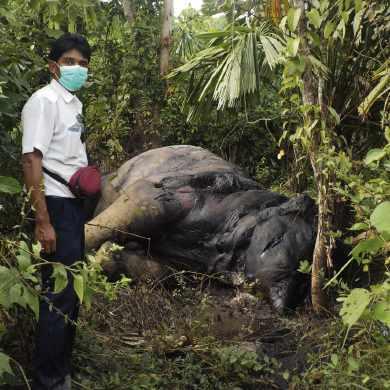
3 minute read
The truth of Blood Beads
Elephants skinned to make Blood Beads
By Marie Kjellsdotter. Photo: Elephant Family
Advertisement
The poaching of African elephants’ ivory tusks is well documented. But halfway around the world in Myanmar, their cousins, the Asian elephants, are ten times more vulnerable. And are now facing a growing new threat – being hunted for their skin.
The research team in Myanmar ‘stumbled across’ a frightening discovery during a routine tracking study at the end of 2014. Peter Leimgruber, Head of Environmental Conservation Ecology at the Smithsonian Conservation Biology Institute, explains what happened in an interview with PBS NewsHour.
“It was actually a big shock. During our monitoring of elephants with GPS collars, we suddenly noticed that some elephants disappeared. Their collars stopped working, and they were gone,” Leimgruber explains and elaborates further,
We had 19 elephants with GPS collars and we knew that five of them had fallen victim to poaching as we had found them dead. And then there were two that had just vanished. Their movement patterns had changed just before their disappearance, in a way that indicated that they were probably also killed by poachers.
After extended search efforts between 2015 and 2017, the research team ended up finding a total of 45 dead elephants in a very limited area. The scope of the poaching was surprising. In contrast to African elephants who live on the open savannah, Asian elephants prefer the jungle’s seclusion, making them very difficult to hunt. “Even our ‘trackers’ have to spend countless hours in order to get through the dense terrain when locating elephants to equip them GPS collars,” states John McEvoy, one of the researchers on site in Myanmar.
Before 2014, poaching of Asian elephants was a relatively rare phenomenon as only some of the males, but not all, have tusks. But with this new skin poaching trend, the poachers now target adult males, adult females, and calves, threatening the whole species. Due to reduced living space, there are only 2,000 wild elephants left in Myanmar (2018), which means that at the current rate, hunting elephants for their skin could wipe out the Myanmar elephant completely within the next 50 years.
Since the end of 2014, Elephant Family has charted poaching and black market trade in elephant skin, which has shown that China is the largest market for elephant skin from Myanmar. “Some skin is sold cut into smaller cubes, which are dried and then processed into beads. The beads get their deep red colour from the blood in the skin. The beads are used to make rosaries, bracelets and necklaces,” explains Belinda.

BLOOD BEADS. The beads are made from the skin of Asian elephants. The skin is cut in cubes and dried, then sanded into beads and polished. The blood red beads are used to make rosaries, bracelets and necklaces.
THE DEADLIEST RED COLOUR. The bead’s red colour comes from the blood in the skin. To give the beads a deeper red colour (perceived as higher quality, with a higher price tag), the elephant is skinned as soon as it falls to the ground while the blood is still fresh under the skin. Cases have even been reported of elephants being skinned alive.
ILLEGAL TRADE. According to international laws, trading of elephant parts, of any kind, from Asian elephants is prohibited, with a few specific exceptions.

Elephant skin is also ground into powder and used in traditional Asian medicine, with undocumented effects. Both beads and powders are marketed openly on social media platforms in China, such as Baidu and WeChat.
The Perfect World has supported Elephant Family’s work since 2014, with contributions to projects such as the undercover work of mapping elephant skin poaching in Myanmar. “This poaching threatens a whole species. And the goal is to skin the elephants as soon as they have fallen to the ground so that the blood, which gives the beads their red colour, is still fresh under the skin,” says Ragnhild Jacobsson, one of the founders of The Perfect World Foundation. She continues,










